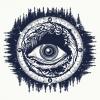 Submitted by Kane on
Submitted by Kane on

Derivative Images
In the 16th century, John Dee, a famed English mathematician, astronomer and astrologer, used an Aztec mirror to make contact with the dead. Dee studied alchemy and divination while straddling the worlds of science and magic, and made extensive use of his mirror while pursuing his occult interests. He was also the official scryer or crystal gazer for Queen Elizabeth I.
The black mirror, made of highly-polished obsidian, was brought to Europe after the conquest of Mexico by Cortés between 1527 and 1530. Mirrors in Mexico were associated with Tezcatlipoca, the dark god of war and sorcery, whose name can be translated as 'Smoking Mirror.' Aztec priests used mirrors for divination and conjuring visions.
No doubt Dee was knowledgeable about the Greek’s use of psychomanteum, or mirror-gazing and that added to his fascination with the Aztec mirror. Among the ancient Greeks, mirror-gazing was a well known means of reaching out to ancestors for guidance. This method frequently involved the use of a dimly lit isolated room with a mirror or reflective surface, such as a pool of water.
You’ve probably heard about the famed Oracle of Delphi, where ancient Greeks journeyed to hear prophecies from a priestess serving as the oracle. Lesser known is the Oracle of the Dead, a site in northwest Greece that pilgrims visited to contact the dead and learn of their future. Built in the third century BC, the Oracle of the Dead included a complex of underground passageways and isolation cells. It was the ancient Greek’s premier psychomanteum, and was also known as The Necromanteion of Ephyra. Pilgrims, who were placed in the cells, fasted and underwent sensory deprivation, exhaustion and disorientation -- all designed to create an environment to induce visions. They also wandered through dark passageways and a stone labyrinth.
After several days or weeks, pilgrims were ready to meet the souls of the dead. They descended to the Sacred Hall in an underground cavern where they were given hallucinogenic leaves or seeds to chew. The pilgrims then gazed into a large copper cauldron filled with water, where they saw visions of the dead in the dark, reflective surface. In their heightened state, it was said that dead friends and relatives sometimes even emerged from the reflective cauldron and appeared as if they were physical beings.
Very little was known about the Greek psychomanteums until 1958 when archaeologist Sotirios Dakaris and his team uncovered a series of small underground rooms connected by a passageway that led to the main chamber where they found the remains of a large copper cauldron ringed with a banister. They had discovered the Oracle of the Dead, spoken of by Homer and Herodotus.
Raymond Moody’s Psychomanteum
One psychomanteum was created in the late 20th century by psychiatrist Raymond Moody. Years after he wrote Life After Life, the classic book on near-death experiences, he wanted to find a way that anyone could connect with the afterlife without having to die briefly and be revived.
Moody, a scholar of ancient Greece, eventually found his answer when he read the Greek magical papyri--scrolls of magical recipes found in Egypt, but written in Greek. By following the instruction of the magical papyri in a facility designed for just this purpose, he had created a modern psychomanteum in the style of the ancient Greeks.
He named his psychomanteum the John Dee Theater of the Mind, and began looking for people willing to step into his ‘apparition booth.’ His goal was to answer the question: Can apparitions of deceased loved ones make themselves known in a controlled environment to normal, healthy people?
In preparation, he would spend hours with a patient, discussing the loved one they wanted to encounter. Then he would escort the person into his mirror-gazing booth and turn on a light that was about as bright as a single candle. He would tell the patient to relax, gaze deeply into the mirror, and think only of the one he wanted to see. They would remain in the booth for as long as they liked and Moody would discuss the experience with the patient afterward.
He was surprised that five of his first ten subjects saw and communicated with an apparition, and all five believed that they had actually connected with a deceased loved one. He had expected only one or two would report contact and figured they would have doubts about the reality of the contact.
His first subject, a 44-year-old nurse whose husband had died two years earlier, made contact, but not in the way that she or Moody had expected. They had talked for hours about her late husband. But when she emerged from the booth, her expression was puzzled. She had made contact, but with her father, not her husband. She was stunned by the experience, because he had actually come out of the mirror to talk to her.
In all, Moody led 300 subjects into the psychomanteum for his mirror-gazing experiment that he wrote about in his book, Reunions. He viewed the room as a therapeutic tool to heal grief and bring insight into the continuity of life.
(Excerpted from The Synchronicity Highway: Exploring Coincidences, the Paranormal & Alien Contact) by Trish MacGregor & Rob MacGregor
© Rob MacGregor - http://www.unexplained-mysteries.com/column.php?id=257269